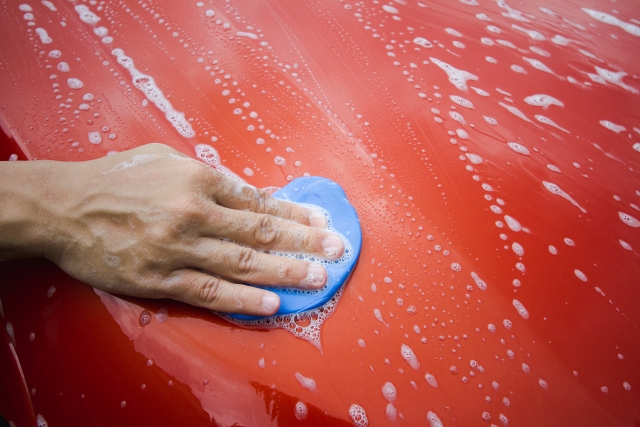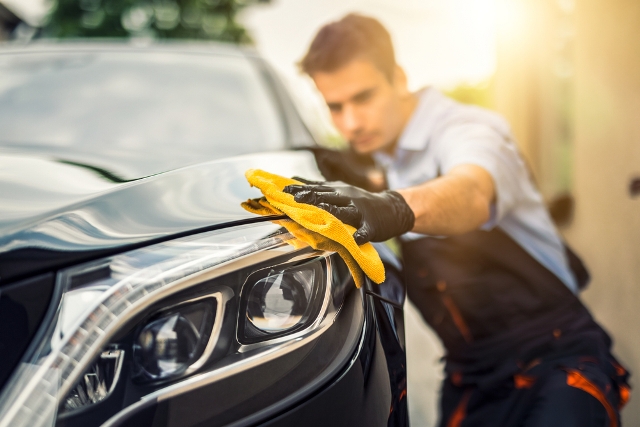Memorial Day weekend comes every year with a myriad of offers from car dealerships nationwide. But if you’re still in the middle of your lease or can’t get yourself in a new car just yet, you can still pull up to a Memorial Day weekend barbecue in a car that looks brand new if you know how to take care of your paint job. We’ll walk you through the exact three-step paint correction process that professionals detailers do.
Before you start on this project make sure to inspect your car for cracks in the paint or areas with exposed metal. These areas will not be repaired by this process, and will need attention of a professional automotive painter. Be sure to have a professional paint these areas, or fill them in to avoid corrosion.
Oxidation, and slight discoloration of paint can be solved but will require more attention than other areas. Knowing how thick the paint of your car is essential when correcting paint. During the compounding process a small layer of paint can be shaved off exposing fresh paint. This process can strip the existing paint off your car, leaving the primer exposed. Find out if your car has ever been repainted to gauge if the paint is too thin to work on.

Step One: Decontamination by Washing and Claying
What you will need:
- Well ventilated, and shaded area to work in
- Hose
- Two buckets
- Wash mitt
- Microfiber towels for drying the car
- Car Shampoo specifically used to remove wax or sealants
- Wheel Brushes
- Clay bar
Optional:
- Wheel cleaner
- Clay bar lubricant
- Tire dressing/tire black
Process:
Washing
- Park your car in a well ventilated area with shade. You can work on your driveway or in your garage.
- Rinse the car down with your hose, making sure to get all the loose dirt off.
- Fill one bucket with water and the other bucket with a mixture of car shampoo and water. Submerge the wash mitt into the bucket with car shampoo.
- Start to wash your vehicle by lathering the roof with the wash mitt from the shampoo bucket.
- Rinse the wash mitt using the bucket filled with water making sure all debris are removed from the mitt.
- Submerge the wash mitt into the bucket of car shampoo and repeat the process.
- Once finished with lathering car shampoo all over the vehicle, rinse it thoroughly with the hose. Make sure no car shampoo is left on the car.
- Using the leftover water from the shampoo bucket, start cleaning the wheels with the wheel brush. Use a stiffer bristle wheel brush for the tires, and a gentle bristle for the mag wheels.
- Rinse the wheels well after cleaning.
- Dry your car well with a clean microfiber towel.
There are debates on whether you should wash the tires first, or last. You will eventually discover your preference after multiple washes. If you use a spray-on wheel cleaner, it is advisable to clean the wheels first so as not to contaminate the clean car body with the spray. Also, you will want to work from the top of your car to the bottom, because the underside of your car collects more contaminants like small rocks and other debris which can scratch the paint.
Clay bar
Clay one panel at a time, making sure to work in small areas.
- Cut a third of your clay bar and form it into a pancake.
- Get the wash mitt used from washing your car and squeeze some water and car shampoo over the area you will be working on.
- Glide over the area with the pancake clay bar making sure to only rub in one direction. Rub the clay up and down for the first pass, then left and right for the second.
- Once the clay bar is contaminated with dirt, fold it into itself and knead the clay into another pancake. If you cannot find a clean portion of clay after kneading, then get yourself a new piece.
- Wipe the panel you were working on and feel the surface. If it is smooth like glass, you have successfully decontaminated the area. If the area still has a rough surface, repeat the process till you get the smoothest finish.
- Repeat the process for the whole vehicle including all the glass and mirrors.

Step Two: Compounding and Polishing
At this point your car is now washed and decontaminated. But if you look at your car from an angle, you’ll still see fine scratches. These are sometimes called love marks, which are etched onto our cars, because of improper cleaning methods. Driving through a car wash can give your cars these small scratches. Compounding, and polishing can make these small scratches disappear.
What is the difference between a Compound and a Polish?
Both compounds and polishes can be used to “cut” the paint or remove a thin layer of paint to even out the swirl marks and small scratches on your car’s paint job. This is achieved from the micro abrasives mixed into the formulation of both the polish and the compound. In a compound, the micro abrasives are bigger than those in the the polish, making it more aggressive and able to cut more effectively. Compounds leave a haze over the paint job, which can be easily fixed by a quick polish.
What you will need:
- Compound of your choice
- Polish of your choice
- Foam applicator pad
- Sponge applicator pad
- Microfiber finishing towel
Optional
- Rotary polishing machine
- Compounding pad
- Polishing pad
Process:
Compounding
Compound in small areas at a time. Work only on one panel at a time.
- Apply 3-4 small dots of compound onto the foam applicator pad and dab the pad on the area you will be working on, making sure to spread the compound.
- With firm pressure and in a circular motion, begin to polish. Move from left to right on the first pass, then up and down on the second pass.
- Wipe the compound off the surface with a microfiber towel after 5-6 passes, or when the compound starts to dissipate.
- Examine the area for swirls, and light scratches. Repeat the process till the area is clear of swirls and light scratches.
This may take some time and repetition so don’t be disheartened if you don’t get your desired results at once.
Polishing
Polish only after you have finished compounding your car.
- Apply 3 dots of polish on the sponge applicator pad and dab the pad on the area you will be working on, making sure to spread the polish.
- With firm pressure and in a circular motion begin to polish. Move from left to right on the first pass, then up and down on the second pass.
- Wipe the polish off with a microfiber towel once it starts to dissipate.
- Examine area for haze left by the compounding process. Repeat the process till the area is clear of haze.
Polishing brings up the clarity in your paint job, and should be done with care. Make sure to look at the area you are working on from different angles to be sure that there is no haze left to correct.
To speed both processes up, you can opt to use a rotary polishing machine. This will also lessen the elbow grease needed to get your car’s shine back. But the fast rotation of the compounding and polishing pads produce heat, and can strip paint faster than expected. When using a rotary polishing machine make sure to keep the pad moving and not stop in a single area.

Step Three: Waxing and Protecting
You have corrected the paint, and all the little imperfections are now gone! To keep the full effect of the compounding and polishing, you need to protect your car with a layer of wax.
What you need:
- Carnauba wax
- Sponge applicator pad
- Microfiber towel
Process:
Waxing
Wax one panel at a time working in small areas. Make sure not to leave the wax on the surface to dry.
- Coat the face of the sponge applicator pad with carnauba wax.
- In a circular motion, lightly apply the carnauba wax on the panel of your car.
- Let the wax sit for a few moments, making sure not to let it dry.
- Wipe the rest of the wax off the surface of the panel with a microfiber towel.
- Buff area with the microfiber towel to let the color pop.
Protection won’t last forever. You’ll have to repeat the waxing process every six months to have a lasting effect on your paint correction.
Keeping your car’s paint in top condition after these processes will be easy. Wash the car every time there is dirt and grime on it. Remove bird droppings, and dead insects as soon as possible to keep the acids from eating into the clear coat. Pull up to that Memorial Day Barbecue and impress all your friends with your showroom looking car.
Any information provided on this Website is for informational purposes only and is not intended to replace consultation with a professional mechanic. The accuracy and timeliness of the information may change from the time of publication.





























